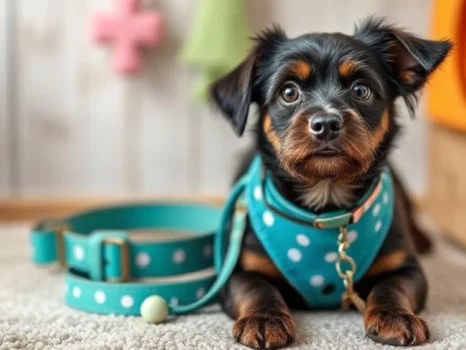How to Choose the Best Accessories for Your Dog
Choosing the right accessories for your dog is essential to ensure their comfort, safety, and overall well-being. Whether you’re a first-time pet owner or looking to upgrade your furry friend’s gear, here are some key factors to consider when selecting dog accessories.
Collars and Harnesses
A collar or harness is a fundamental accessory for any dog. When choosing one, consider the size, material, and purpose:
- Size & Fit: Ensure the collar is snug but not too tight. You should be able to fit two fingers between the collar and your dog’s neck.
- Material: Leather, nylon, and neoprene are popular options, each offering different levels of durability and comfort.
- Harness vs. Collar: A harness is ideal for small breeds or dogs that pull on the leash, as it reduces strain on the neck.
Leashes
A leash provides control and safety during walks. Consider:
- Length: Standard leashes (4-6 feet) offer better control, while retractable leashes provide more freedom.
- Material: Nylon is lightweight and affordable, while leather is durable and stylish.
- Handle Comfort: Padded handles can reduce hand strain during long walks.
Beds and Crates
Your dog needs a comfortable place to rest. When selecting a bed or crate:
- Size: Ensure the bed or crate is large enough for your dog to stretch out comfortably.
- Support: Orthopedic beds are great for senior dogs with joint issues.
- Washability: A removable, machine-washable cover is a convenient feature.
Food and Water Bowls
Choosing the right bowls ensures proper feeding and hydration:
- Material: Stainless steel is durable and hygienic, while ceramic adds style and weight to prevent tipping.
- Height: Elevated bowls help large or senior dogs eat more comfortably.
- Non-Slip Base: Prevents spills and messes during mealtime.
Toys
Toys keep dogs entertained and mentally stimulated:
- Chew Toys: Ideal for teething puppies and heavy chewers.
- Interactive Toys: Puzzle toys can help with cognitive development.
- Durability: Choose toys made from safe, non-toxic materials that withstand rough play.
Grooming Tools
Regular grooming is essential for your dog’s hygiene:
- Brushes & Combs: Choose based on your dog’s coat type (short, long, curly, or shedding).
- Nail Clippers: Keep nails trimmed to prevent overgrowth and discomfort.
- Shampoo & Conditioner: Use dog-specific formulas to avoid skin irritation.
Clothing and Protective Gear
For certain climates or breeds, clothing can provide added comfort:
- Sweaters & Coats: Great for small or short-haired dogs in cold weather.
- Booties: Protect paws from hot pavement, cold snow, or rough terrain.
- Raincoats: Waterproof options keep dogs dry on rainy days.
Identification and Safety Gear
Ensure your dog’s safety with proper identification:
- ID Tags: Include your contact information in case your dog gets lost.
- Microchips: A permanent identification method for added security.
- Reflective Gear: Helps make your dog visible during nighttime walks.
Why Dogs Need Toys
Toys are essential for a dog’s mental and physical well-being. Providing your dog with the right toys can enhance their quality of life and prevent behavioral issues. Here are some key reasons why dogs need toys:
1. Mental Stimulation
Dogs are intelligent creatures that need mental engagement to stay happy. Puzzle toys and treat-dispensing toys challenge their minds and prevent boredom, reducing destructive behaviors.
2. Physical Exercise
Toys encourage physical activity, keeping dogs active and healthy. Fetch toys, tug ropes, and chew toys help dogs burn energy and maintain a healthy weight.
3. Teething Relief
For puppies, teething can be uncomfortable. Chew toys help soothe sore gums and prevent them from chewing on furniture or other household items.
4. Behavioral Development
Toys can help reinforce positive behaviors. Reward-based toys encourage obedience, while tug toys can teach dogs controlled play.
5. Anxiety Reduction
Dogs can experience anxiety when left alone. Comfort toys, such as plush toys with familiar scents, can provide security and reduce stress.
6. Bonding and Socialization
Interactive toys foster a strong bond between dogs and their owners. They also promote socialization when playing with other dogs, improving their social skills.
7. Preventing Destructive Behavior
A bored dog is more likely to engage in destructive behavior. Toys keep them occupied and provide an appropriate outlet for their natural chewing instincts.
Conclusion
Choosing the right accessories for your dog depends on their specific needs, size, and lifestyle. Prioritize safety, comfort, and durability when making your selections. By investing in quality accessories, you can enhance your dog’s well-being and make pet ownership more enjoyable for both of you.








